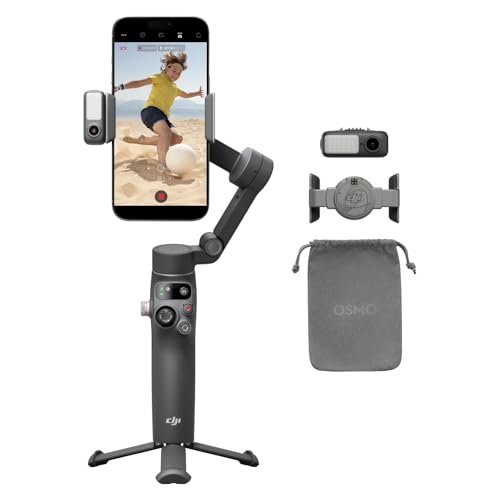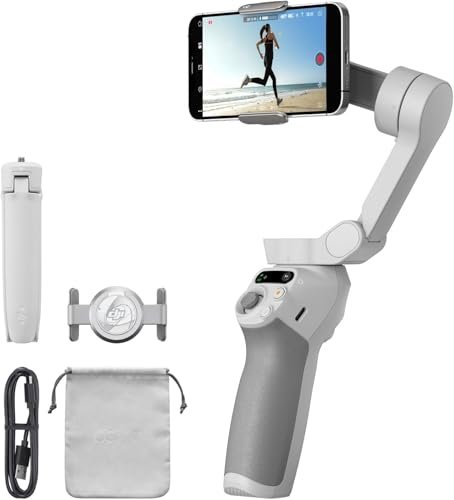Got a fantastic Sony a6500 but still battling with shaky, jarring video footage? You’re not alone! While your a6500 is a brilliant mirrorless camera, especially for video, adding a quality gimbal stabilizer can truly transform your output. Imagine silky-smooth cinematic shots, dynamic moving timelapses, or effortless vlogging footage – that’s the magic a good gimbal brings to the table.
In this guide, we’re diving deep into some of the best gimbal for Sony a6500 options out there. We’ll break down what makes each one special, looking at key features, pros, cons, and what users really think. Ready to take your Sony a6500 video quality to the next level? Let’s jump in!
1. DJI RS 3 Mini

The DJI RS 3 Mini is a game-changer for content creators who prioritize portability without sacrificing performance. It’s incredibly lightweight and compact, making it an ideal travel companion for your Sony a6500. Don’t let its size fool you, though; this little powerhouse packs a punch, offering robust stabilization thanks to DJI’s renowned 3rd-Gen RS Stabilization Algorithm. Whether you’re shooting low-angle shots or quick, on-the-go footage, the RS 3 Mini ensures your videos stay buttery smooth.
Key Features:
– 795g (1.75lbs) Lightweight and Portable design, perfect for extended shooting sessions.
– Wide-Ranging Compatibility with a load capacity of up to 2 kg (4.4 lbs), suitable for the a6500 with various lenses.
– Bluetooth Shutter Control for seamless photo and video recording via the gimbal.
– 3rd-Gen RS Stabilization Algorithm for professional-level image stabilization.
– Native Vertical Shooting capability, making social media content creation a breeze.
– 1.4″ Full-Color Touchscreen with an intuitive UI for easy settings access.
Pros:
– Extremely portable and lightweight for easy transport.
– Excellent stabilization performance for its size.
– Supports native vertical shooting without extra accessories.
– Intuitive touchscreen and Bluetooth control enhance usability.
Cons:
– Requires the DJI Ronin app for full functionality and activation.
– Payload, while decent, might be limiting for very heavy lens setups.
User Impressions: Users consistently praise the RS 3 Mini for its remarkable balance of portability and power. Many note how it effortlessly handles their mirrorless setups, including the a6500, delivering surprisingly stable footage for such a compact device. It’s a favorite for run-and-gun filmmakers and travel vloggers alike.
2. FeiyuTech SCORP-C [Official] Camera Stabilizer 3-Axis
![FeiyuTech SCORP-C [Official] Camera Stabilizer 3-Axis...](https://m.media-amazon.com/images/I/41cuk84JumL._SL500_.jpg)
If you’re looking for a gimbal that can handle a bit more weight and offers an integrated, ergonomic design, the FeiyuTech SCORP-C is definitely worth considering for your Sony a6500. This upgraded model boasts an impressive payload capacity, making it versatile for a wider range of camera and lens combinations. Its integrated handle grip means you won’t need extra accessories for an underslung mode, providing a solid, comfortable hold for those longer shooting sessions.
Key Features:
– Compatible with mainstream mirrorless and DSLR camera & lens combos, including the Sony a6500.
– Upgraded Payload of up to 5.51 lbs, offering more flexibility for heavier lenses.
– Integrated Handle Grip design, ensuring stability and comfortable handling.
– Multi-Functional Knob Ring for precise control over camera focus and gimbal axis movements.
– Specifically listed compatibility for Sony Alpha series cameras, including a6500, a6400, a6300, and more.
Pros:
– High payload capacity for diverse lens options.
– Integrated handle design improves grip and stability.
– Multi-functional knob provides versatile control.
– Robust build quality for reliable performance.
Cons:
– Can be slightly heavier than ultra-compact gimbals due to its design.
– May feel less agile for extremely quick, lightweight shots compared to mini versions.
User Impressions: Many users are impressed by the SCORP-C’s sturdy build and its ability to effortlessly carry larger camera setups. The integrated handle is a significant plus, offering a more comfortable and secure grip. Videographers appreciate the precise control offered by the multi-functional knob, which makes on-the-fly adjustments a breeze.
3. ZHIYUN CINEPEER WEEBILL 3E 3-Axis Gimbal Stabilizer

The ZHIYUN CINEPEER WEEBILL 3E stands out with its focus on user comfort and efficient vertical shooting, making it a strong contender for your Sony a6500, especially if you create content for social media. Weighing only 1.05 kg (A4-sized), it’s deceptively light given its robust 3 kg (6.6 lbs) payload capacity. But where it really shines is its native vertical shooting capability and ergonomic handle design, significantly reducing physical fatigue during prolonged use.
Key Features:
– Native Vertical Shooting: Quick and easy transfer to vertical mode without additional accessories or disassembly.
– Bluetooth Shutter Control: Wirelessly control recording and photo functions after initial pairing.
– Long Battery Life: Built-in 2600mAh batteries provide up to 16 hours of use, with 14W fast charging in just 2 hours 46 minutes.
– Small But Strong: Weighs 1.05 kg (A4-sized) yet supports a 3 kg (6.6 lbs) payload.
– 2.5 Sling Mode (requires separate purchase of wrist rest and telescopic sling handle) to reduce physical fatigue by over 50%.
Pros:
– Excellent battery life with fast charging capabilities.
– Effortless native vertical shooting for social media.
– Ergonomic design for comfortable, long-term shooting.
– Lightweight yet robust payload capacity.
Cons:
– Optional accessories like the sling grip and wrist rest are not included in the standard package.
– Requires purchasing specific control cables for non-Panasonic cameras (like Sony) if not already owned.
User Impressions: Content creators love the Weebill 3E for its exceptional battery life and how comfortable it feels even after hours of shooting. The seamless switch to vertical mode is a huge bonus for those frequently producing content for platforms like TikTok or Instagram Reels. Many find it perfectly suited for their Sony a6500 setups.
4. ZHIYUN Weebill 2, 3-Axis Gimbal Stabilizer for DSLR and Mirrorless Cameras
![ZHIYUN CINEPEER Weebill 3E[Official], 3-Axis Lightweight...](https://m.media-amazon.com/images/I/41+kdEh7b2L._SL500_.jpg)
The ZHIYUN Weebill 2 takes stabilization and control to a whole new level, making it one of the best gimbal for Sony a6500 users seeking professional-grade features. Its standout feature is the integrated 2.88″ full-color flip-out touchscreen, which allows for intuitive parameter adjustments without needing a separate app or phone. Coupled with a powerful new Infineon chip, the Weebill 2 delivers incredibly smooth and responsive stabilization, even with heavier camera setups.
Key Features:
– New Infineon Chip: Provides dynamic stabilization for smoother follow and quicker response.
– Effort-saving Sling Grip: Classic Weebill structure for comfortable, low-angle shooting.
– 2.88″ Full-Color Flip-out Touch Screen: Integrated screen for direct parameter adjustments.
– Focus Control Wheel: Easily customizable for roll axis control, aperture, ISO, or focus motor adjustment.
– Wider Compatibility: Supports a broad range of DSLR and mirrorless cameras, including the Sony a6500, A7 series, and more.
Pros:
– Integrated flip-out touchscreen offers unparalleled ease of use and control.
– Advanced stabilization chip for superior, responsive performance.
– Versatile sling grip design for comfortable low-angle shots.
– Customizable control wheel enhances shooting flexibility.
Cons:
– Larger and potentially heavier than mini gimbals, impacting extreme portability.
– The touchscreen, while convenient, can be a battery drain if used extensively.
User Impressions: Users frequently highlight the Weebill 2’s innovative flip-out touchscreen as a game-changer, making setup and on-the-fly adjustments incredibly efficient. The enhanced stabilization is also a major talking point, with many calling it an industry leader for achieving cinematic, stable footage with their Sony a6500 and other mirrorless cameras.
Factors to Consider When Choosing Your Gimbal for Sony a6500
Picking the perfect gimbal for your Sony a6500 involves more than just looking at cool features. Here’s a quick rundown of what to keep in mind:
- Payload Capacity: This is crucial! Make sure the gimbal can comfortably handle the weight of your Sony a6500 plus your heaviest lens and any accessories (like external mics or small lights). Always check the gimbal’s max payload and your setup’s total weight.
- Portability & Size: Are you a run-and-gun shooter, a travel vlogger, or mostly studio-based? A compact, lightweight gimbal like the DJI RS 3 Mini is great for travel, while a larger one might offer more stability and features for heavier setups.
- Battery Life: Longer battery life means fewer interruptions during shooting. Fast charging is also a huge plus!
- Stabilization Performance: While all gimbals stabilize, some do it better than others. Look for advanced algorithms and smooth motor responses for the best results.
- Control Features & Ergonomics: Does it have an intuitive display? Can you control camera settings directly from the gimbal? Is it comfortable to hold for extended periods? Features like customizable buttons, joysticks, and touchscreens can make a big difference.
- Compatibility: Double-check that the gimbal fully supports your Sony a6500, especially for features like shutter control, focus, and zoom. Most modern gimbals offer excellent compatibility, but it’s always good to confirm.
Frequently Asked Questions (FAQ)
1. Why do I need a gimbal for my Sony a6500?
The Sony a6500 has excellent in-body image stabilization (IBIS), but for truly cinematic, smooth, and professional-looking video footage, especially with movement (walking, panning, tilting), a 3-axis gimbal is essential. It isolates your camera from accidental shakes and movements, ensuring buttery-smooth results that IBIS alone can’t achieve.
2. What’s the difference between 3-axis and 2-axis gimbals?
A 3-axis gimbal stabilizes across all three axes: pan (left-right rotation), tilt (up-down rotation), and roll (sideways rotation). This provides the most comprehensive stabilization. A 2-axis gimbal typically stabilizes only pan and tilt, leaving some roll movement, which makes it less effective for dynamic shots. For the best gimbal for Sony a6500 performance, a 3-axis gimbal is highly recommended.
3. How do I balance my Sony a6500 on a gimbal?
Balancing involves adjusting the camera’s position on each axis (tilt, roll, pan) until it remains level and doesn’t drift when the motors are off. This ensures the motors don’t have to work harder than necessary, saving battery and improving stabilization. Most gimbals come with clear instructions or app tutorials to guide you through the balancing process, which is critical for optimal performance.
4. Can I use any lens with my Sony a6500 on a gimbal?
While you can technically mount many lenses, the key factor is the total weight (camera + lens + accessories) staying within the gimbal’s payload capacity. Also, some longer or heavier lenses might affect the gimbal’s balance or range of motion. Always check the gimbal’s compatibility list and test your setup before a shoot.
5. What is “native vertical shooting” on a gimbal?
Native vertical shooting allows you to quickly switch your camera’s orientation from horizontal (landscape) to vertical (portrait) without needing extra L-brackets or complex re-balancing. This feature is a huge time-saver for content creators who frequently shoot for social media platforms like TikTok, Instagram Reels, or YouTube Shorts.
6. How important is battery life for a gimbal?
Very important! A gimbal with good battery life ensures you can shoot for extended periods without interruption. Nobody wants to run out of power in the middle of a crucial shot. Look for gimbals offering several hours of operation and, ideally, fast charging capabilities.
7. Are gimbals hard to learn?
Modern gimbals are much more user-friendly than older models. While there’s a slight learning curve to balancing and mastering specific camera movements, most users can get comfortable with basic operation fairly quickly. Online tutorials and manufacturer apps often provide excellent guidance to help you get started.
Conclusion
Finding the best gimbal for Sony a6500 truly depends on your specific shooting style, budget, and the types of lenses you plan to use. Whether you prioritize ultra-portability with the DJI RS 3 Mini, robust versatility with the FeiyuTech SCORP-C, ergonomic comfort with the ZHIYUN CINEPEER WEEBILL 3E, or advanced control with the ZHIYUN Weebill 2, there’s an excellent option out there for you.
Investing in a quality gimbal will dramatically elevate your video content, allowing you to capture the smooth, professional-looking footage your Sony a6500 is truly capable of. Happy shooting!


